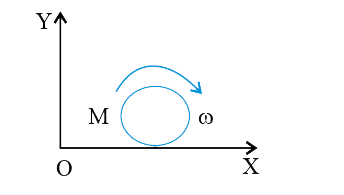Experience shows that a body irradiated with light with circular polarization acquires a torque. This happens because such a light possesses an angular momentum whose flow density in vacuum is equal to M=I/ω, where I is the intensity o flight, ω is the angualr oscillation frequacny. Suppose light with circualr polarization and wavelength λ=0.70μm falls normally on a uniform black disc of mass m=10mg which can freely rotate about its axis. How soon will its angualr velocity become equal to ω0=1.0rad/s provided I=10W/cm2?
Let r= radius of the disc
then its moment of inertia about its axis =12mr2
In time t the disc will acquire an angualr momentum
t.πr2.Iω
when circularly polarized light of intensity I falls on it. By conservation of angualr momentum this must equal
12mr2ω0
where ω0= final angualr velocity.
Equating t=mωω02πI
But ω2π=v=cλ so t=mcω0Iλ
Subsituting the values of the various quantities we get
t=11.9hours
Topper's Solved these Questions
- BOOK - IE IRODOV, LA SENA & SS KROTOVCHAPTER - OPTICSEXERCISE - Dispersion And Absorption Of Light24videos
OPTICS
- BOOK - IE IRODOV, LA SENA & SS KROTOVCHAPTER - OPTICSEXERCISE - Optics Of Moving Sources22videos
OPTICS
- BOOK - IE IRODOV, LA SENA & SS KROTOVCHAPTER - OPTICSEXERCISE - Diffraction Of Light60videos
OPTICS
- BOOK - IE IRODOV, LA SENA & SS KROTOVCHAPTER - MECHANICSEXERCISE - Mechanics Problems92videos
MECHANICS
- BOOK - IE IRODOV, LA SENA & SS KROTOVCHAPTER - OSCILLATIONS AND WAVESEXERCISE - Electromagnetic Waves, Radiation36videos
OSCILLATIONS AND WAVES
Similar Questions
Knowledge Check
- Question 1 - Select One
When an unpolarised light is polarized, then the intensity of light of the polarized waves
Aremains sameBdoubledChalvedDdepends on the colour of the light. - Question 2 - Select One
The angular momentum of a body with mass (m) moment of inertia (I) and angular velocity (ω) rad/s is equal to
AIωBIω2CIωD1ω2 - Question 3 - Select One
When an unpolarized light of intensity I0 is incident on a polarizing sheet, the intensity of the light which does not get transmitted is
AZeroBI0C12I0D14I0
A disc of mass M and radius R is rolling with angular speed w on horizontal plane as shown. The magnitude of angular momentum of the disc about the origin O is :
 View Solution
View SolutionWhen an unpolarized light of intensity I0 is incident on a polarizing sheet, the intensity of the light which does not get transmitted is
View SolutionWhen an unpolarized light of intensity I0 is incident on a polarizing sheet, the intensity of the light which does not get transmitted is
View SolutionWhen an unpolarized light of intensity I0 is incident on a polarizing sheet, the intensity of the light which dows not get transmitted is
View SolutionWhen an unpolarised light of inensity I0 is incident on a polarizing sheet, the intensity of the light which does not get transmittted is
View Solution
